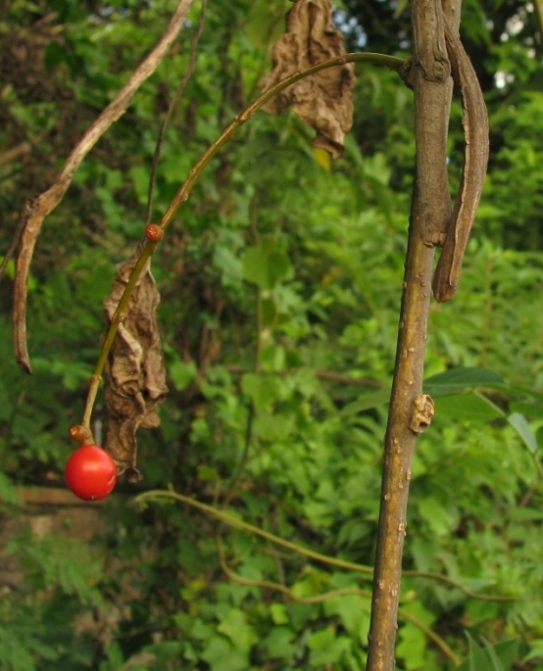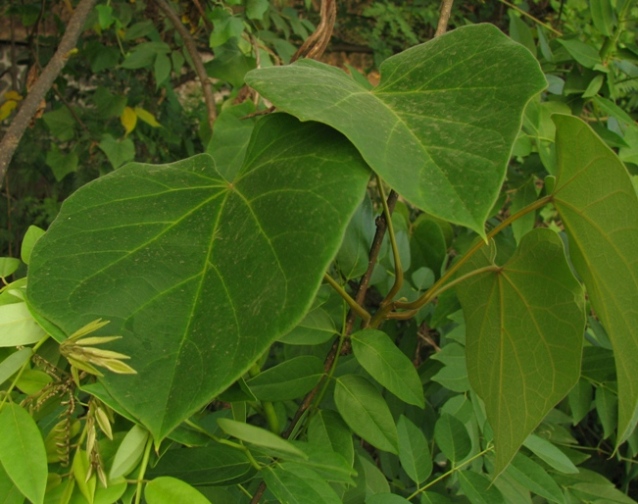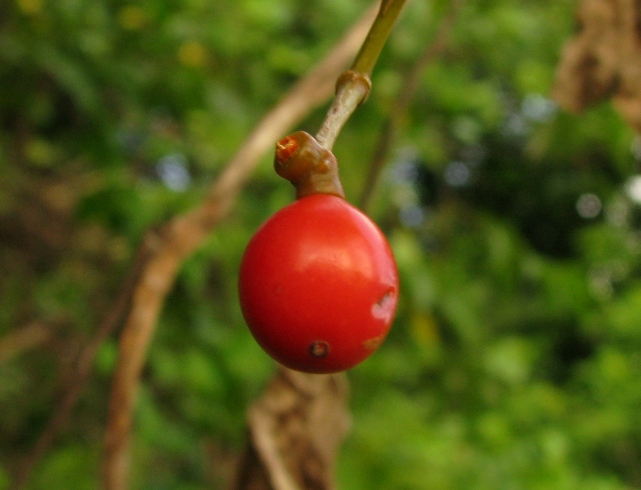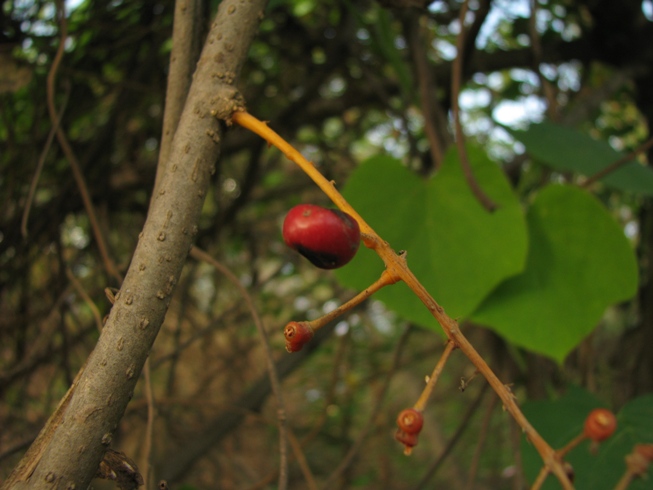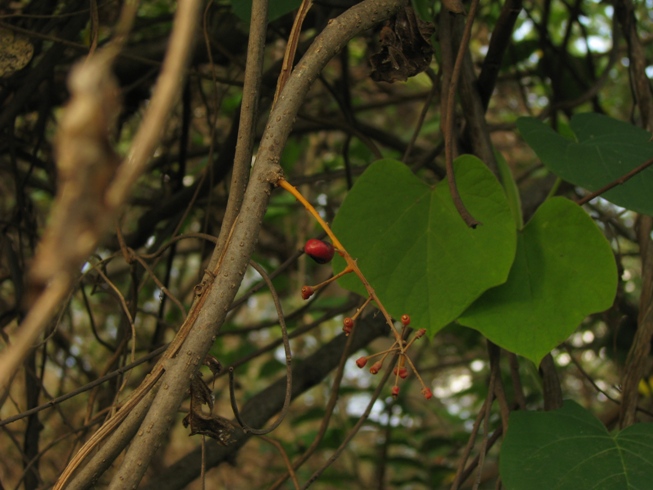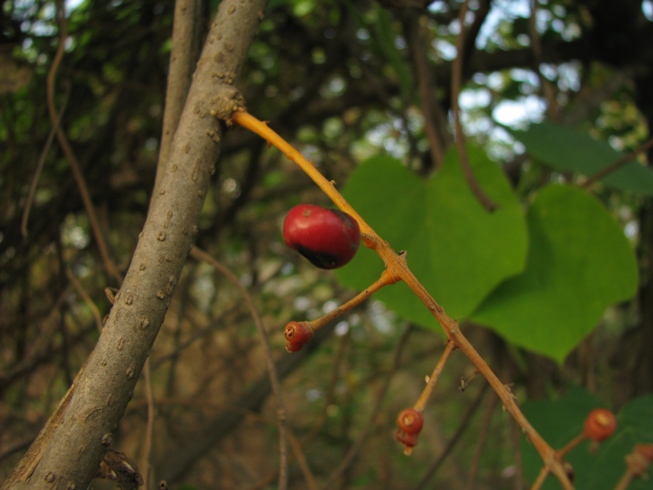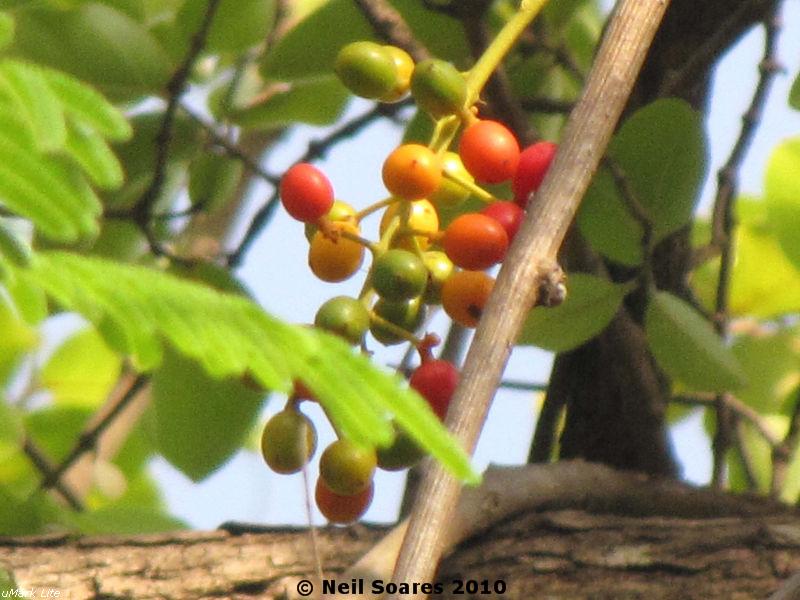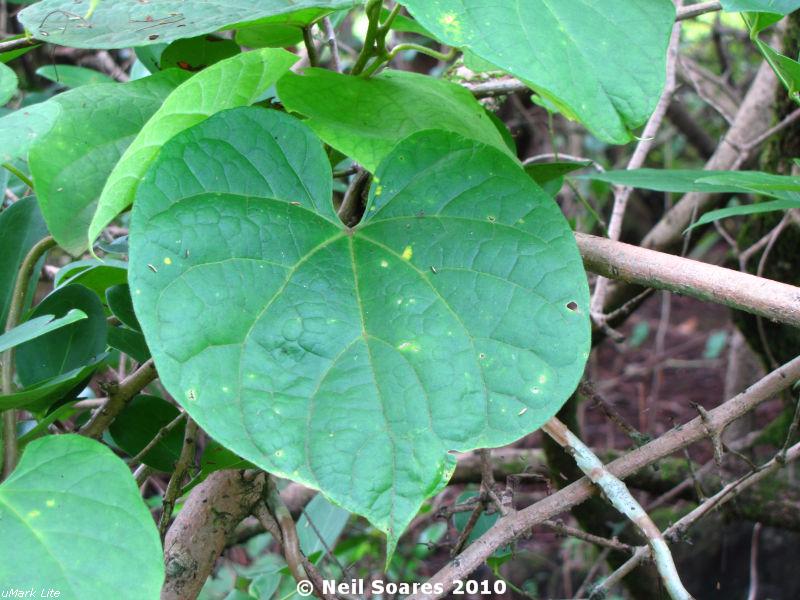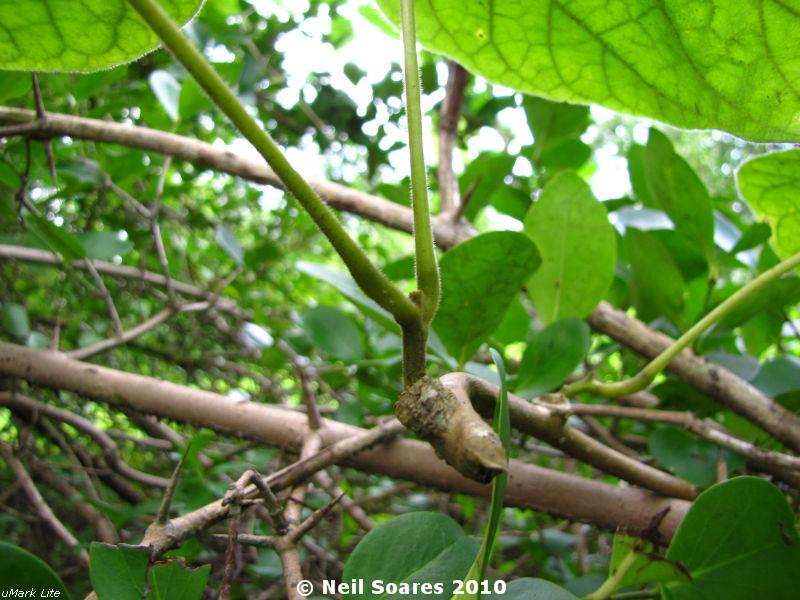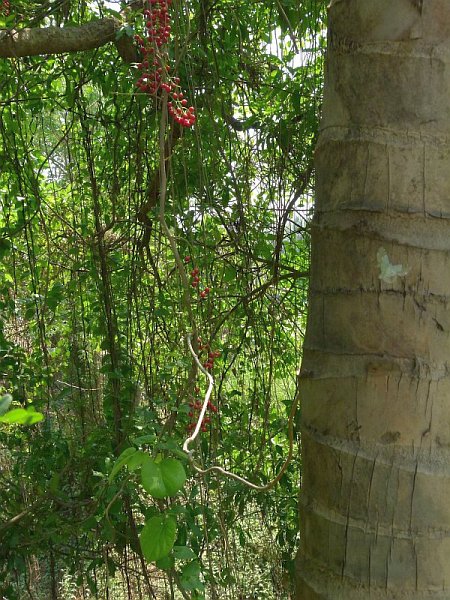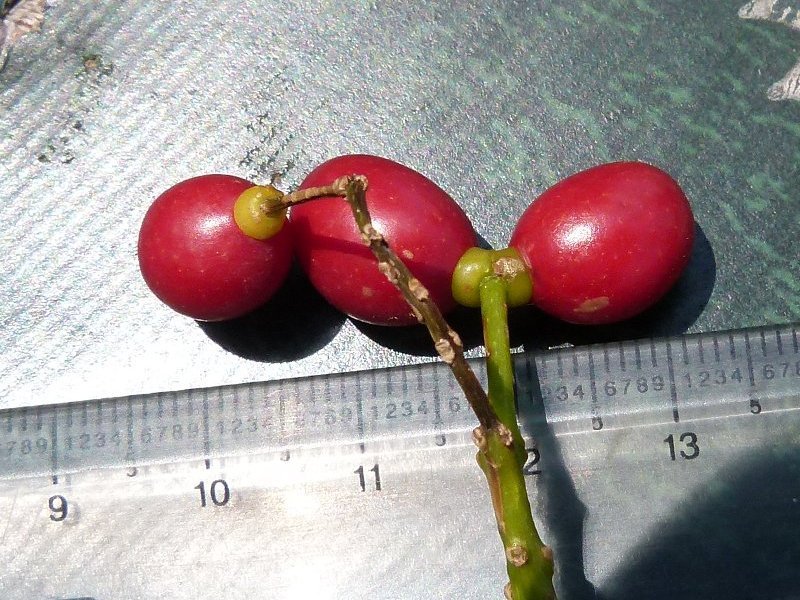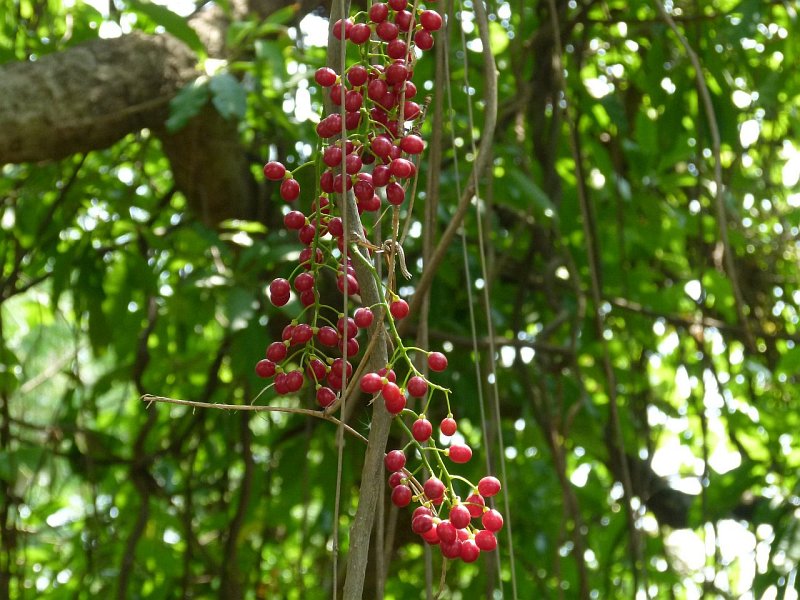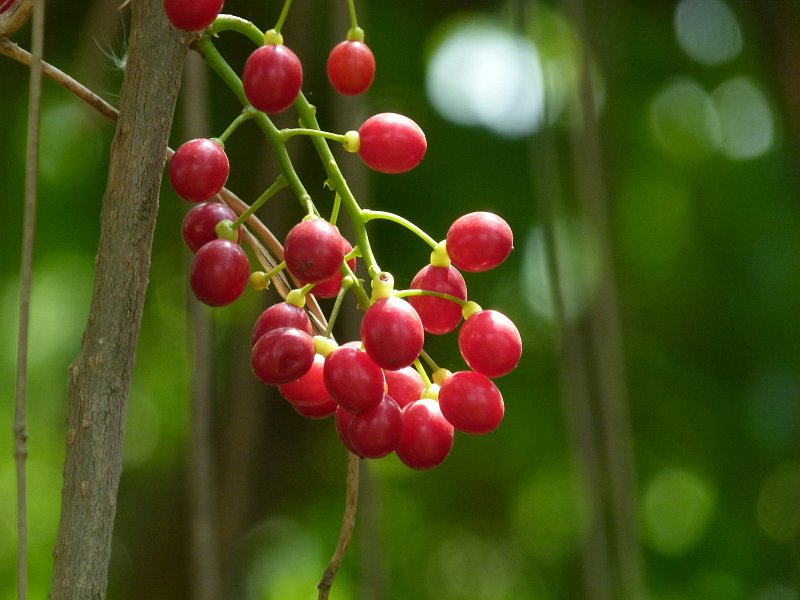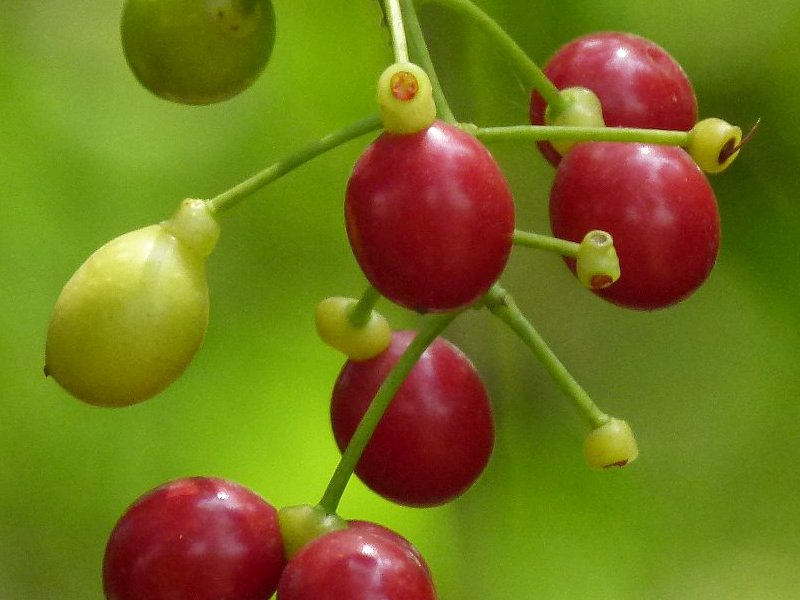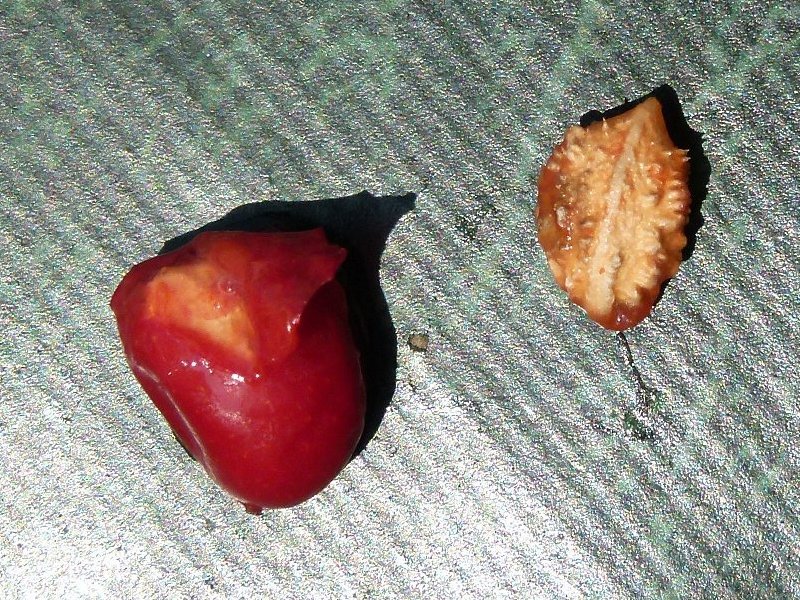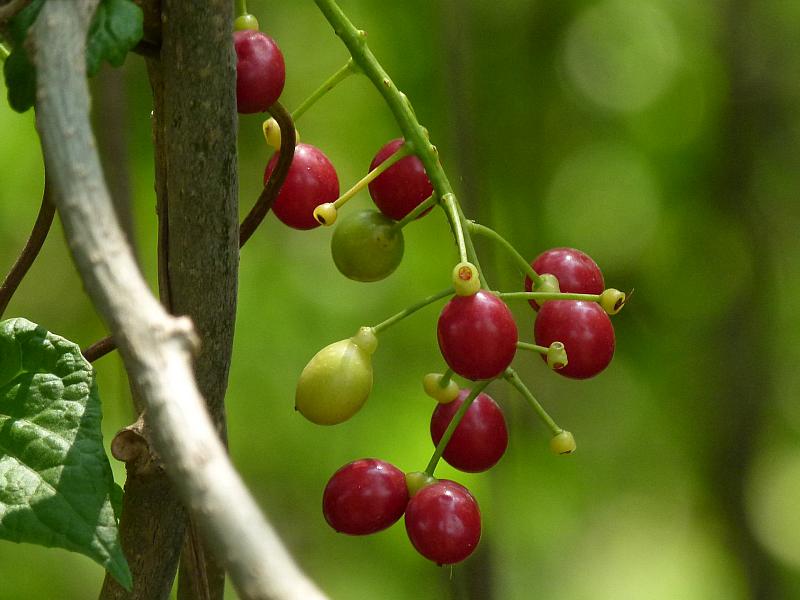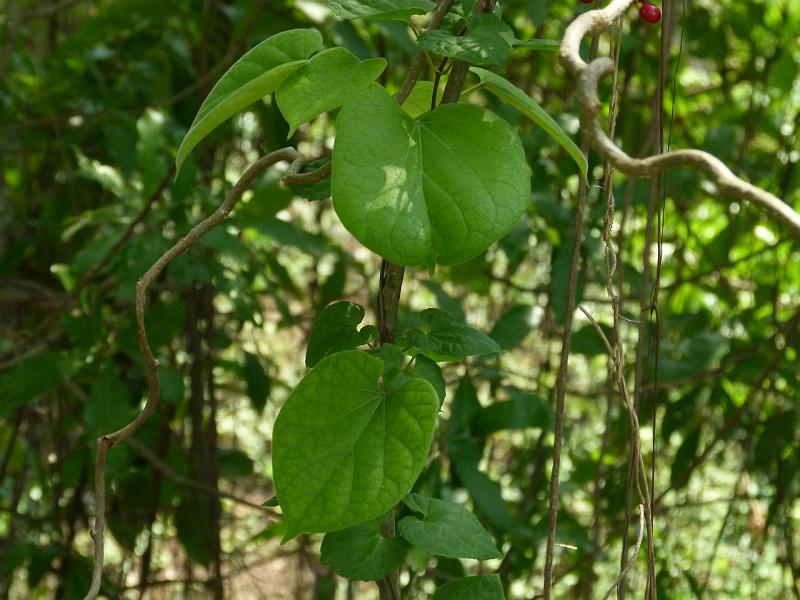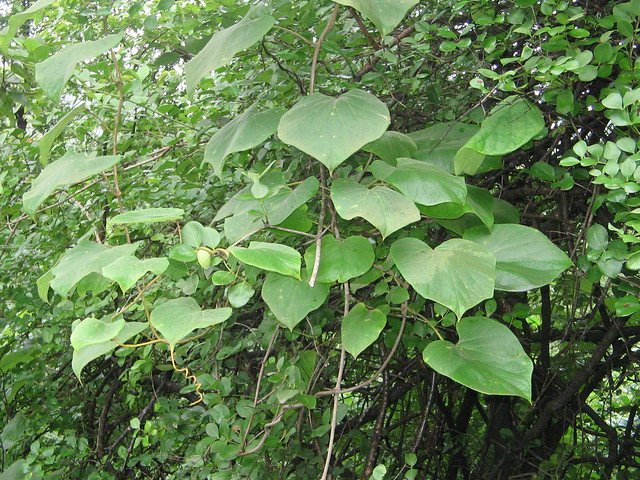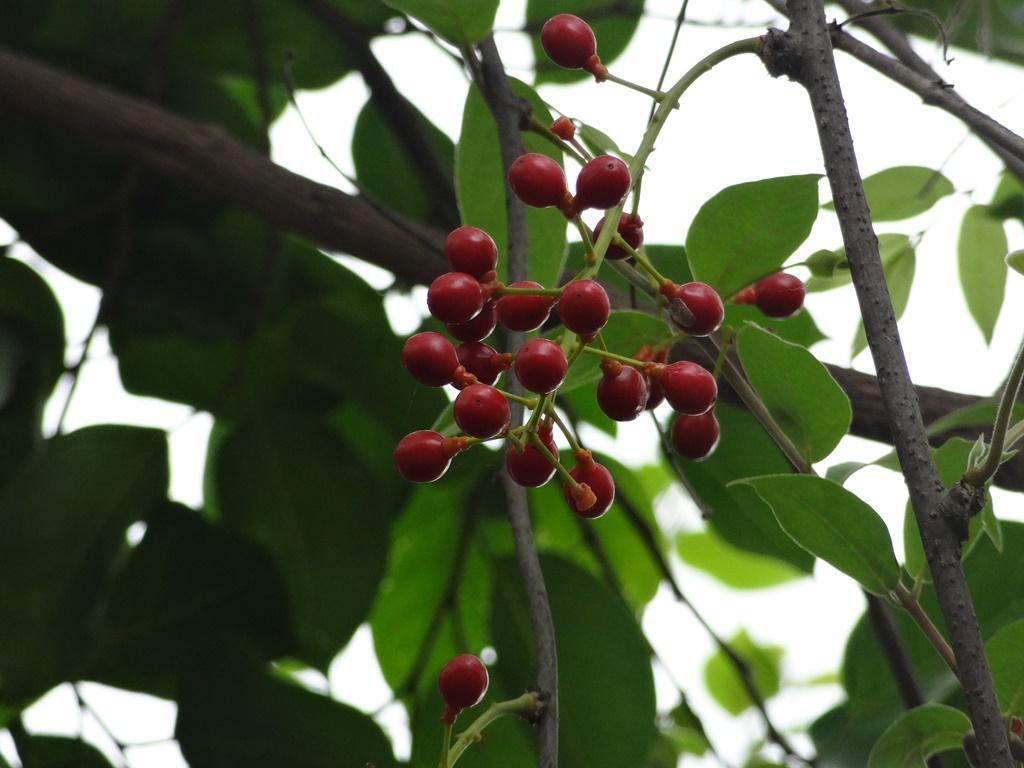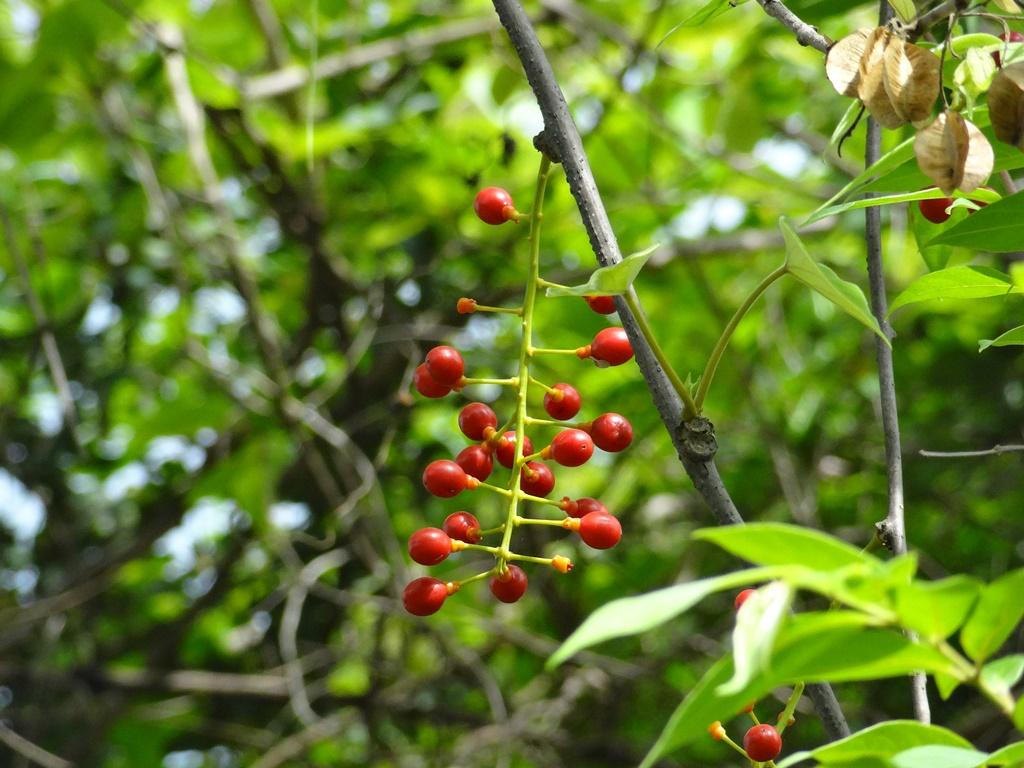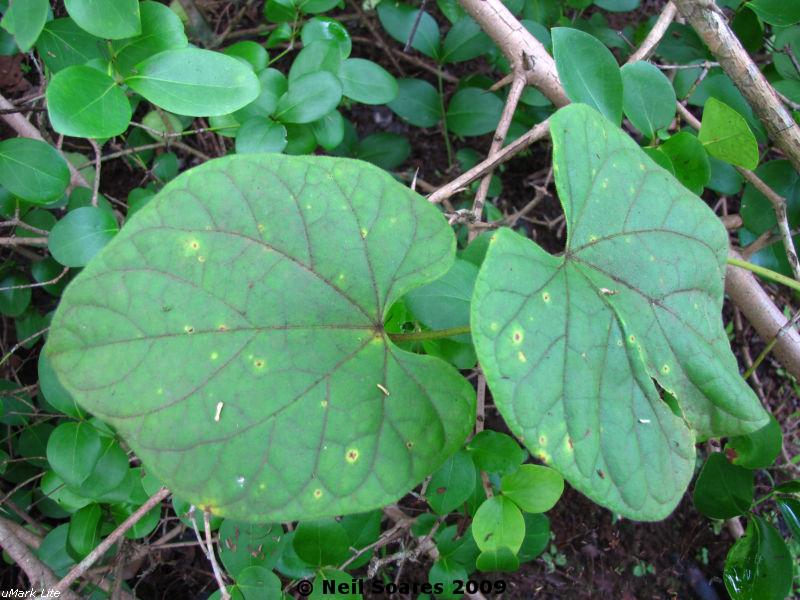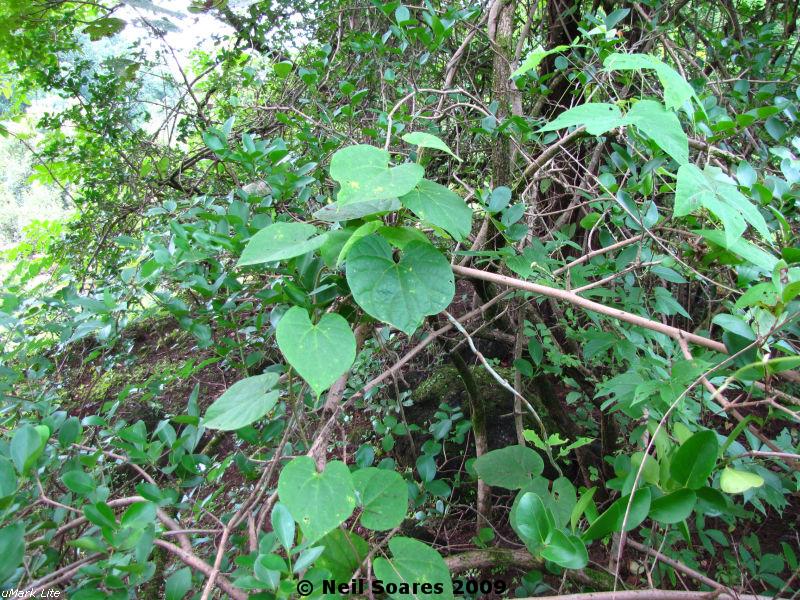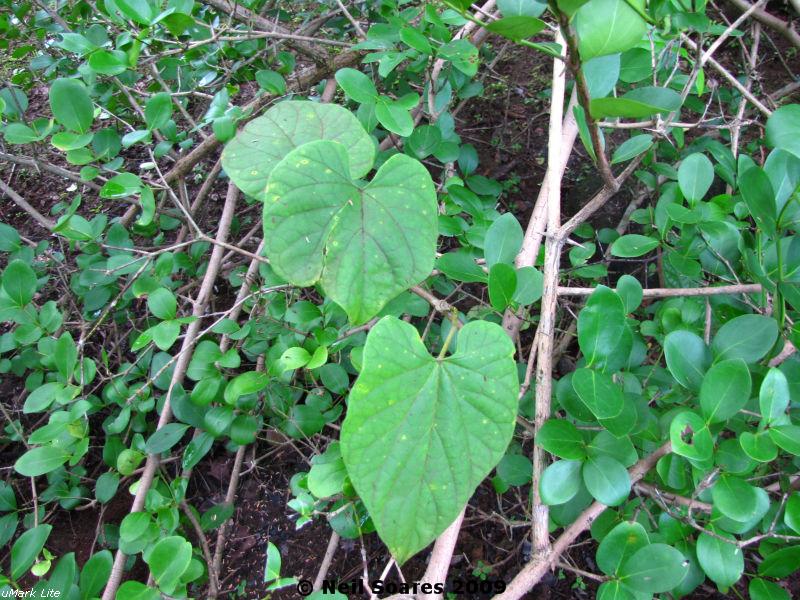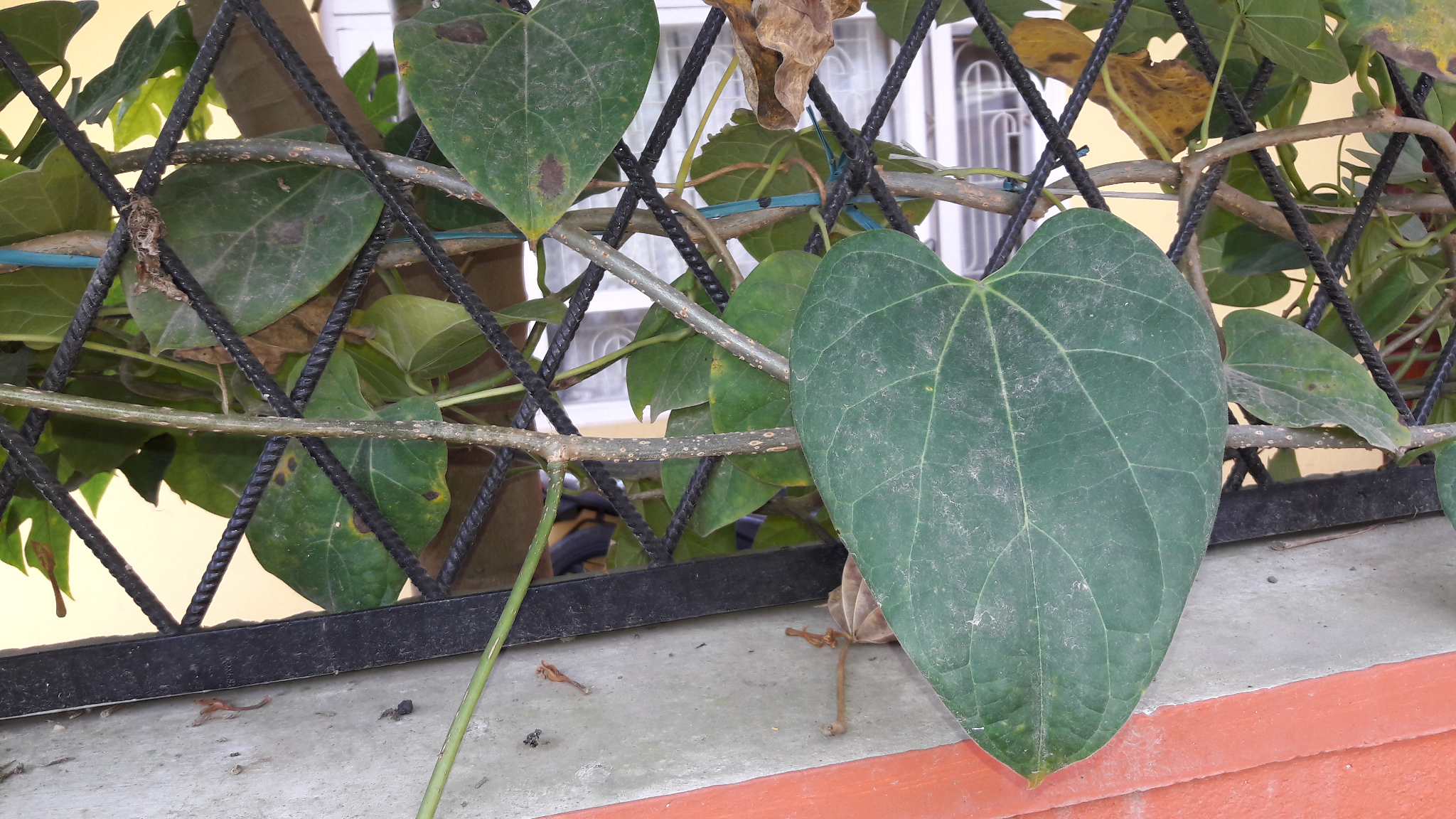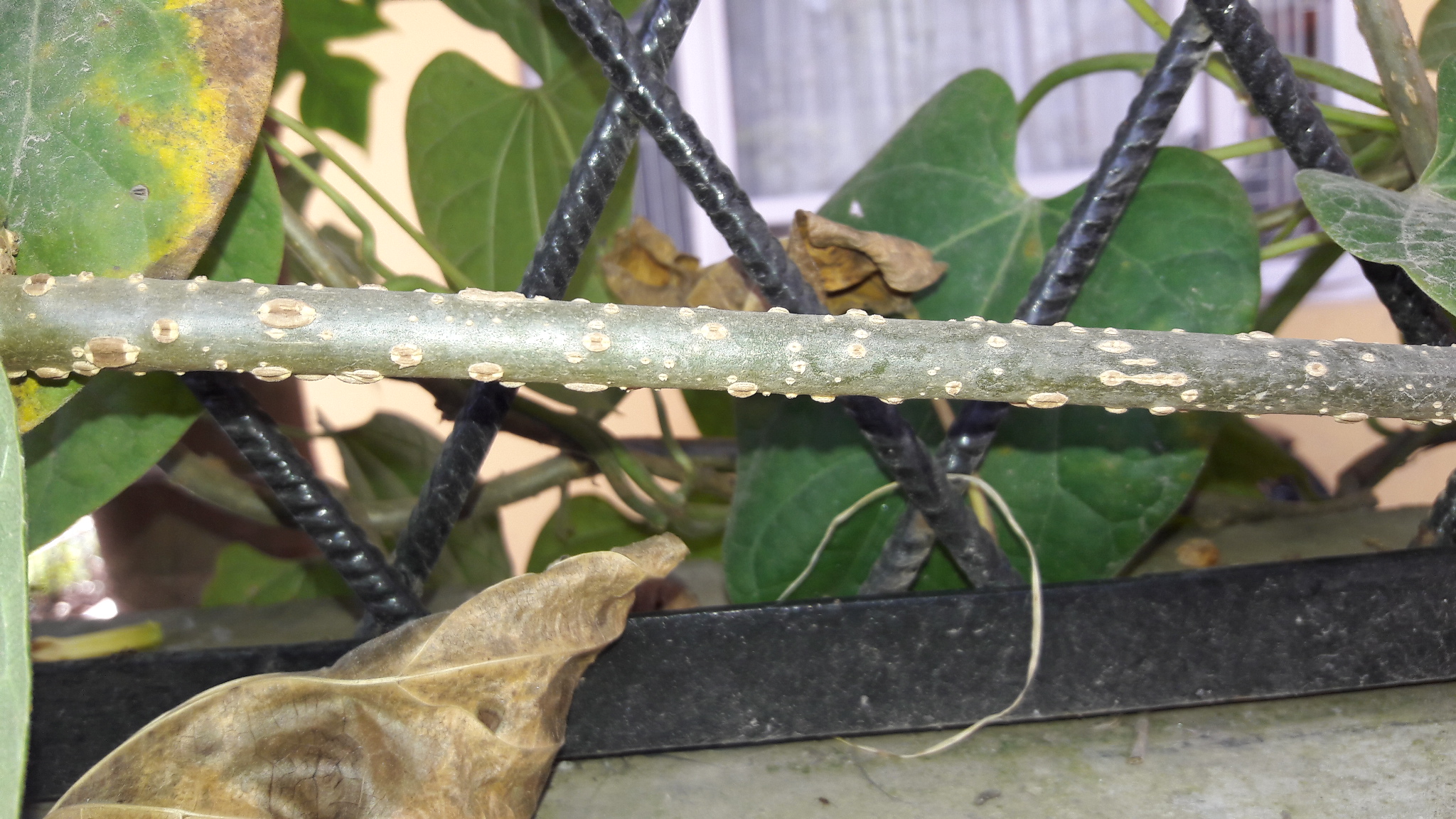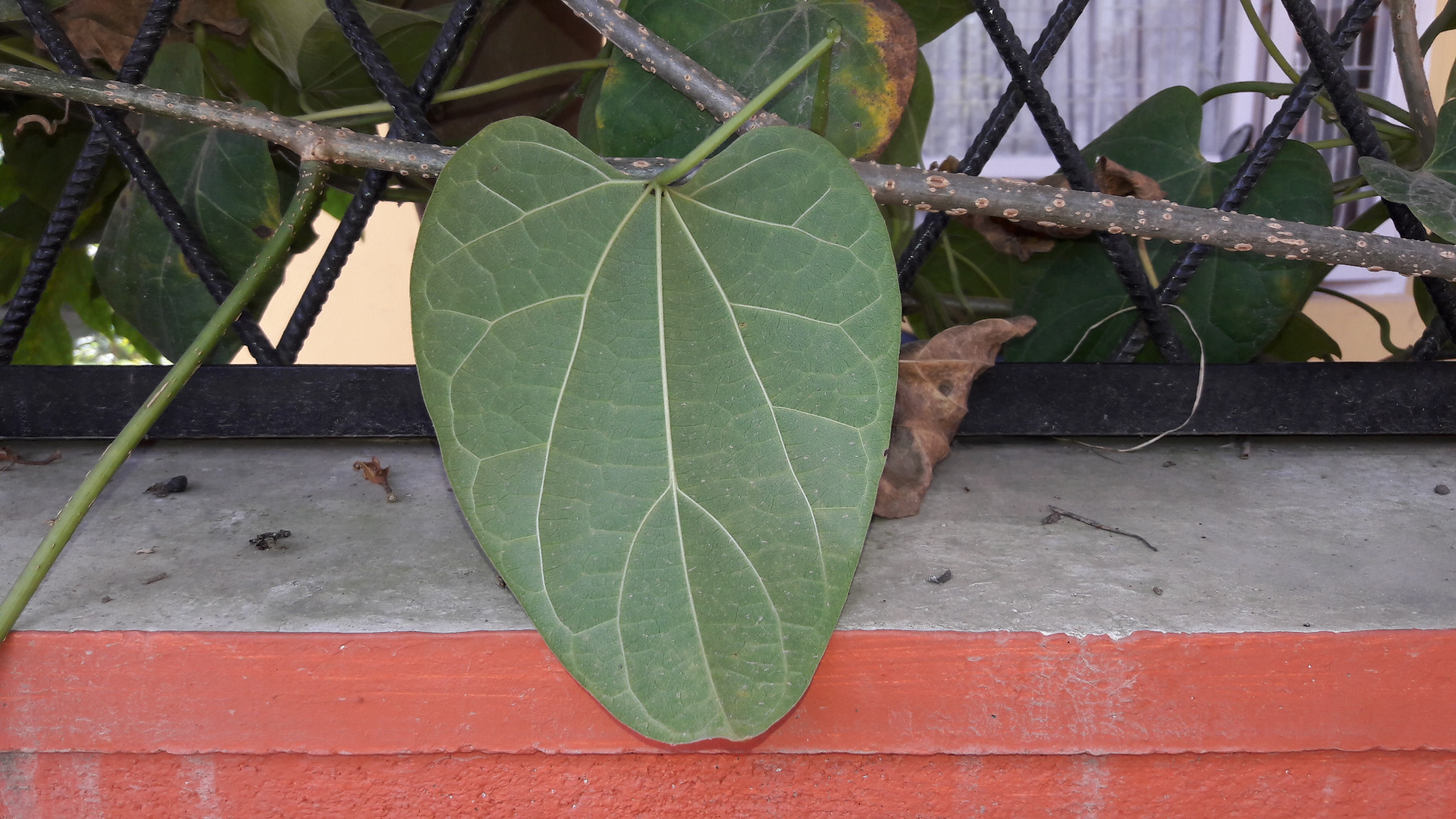|
Tinospora sinensis (Lour.) Merr. , Sunyatsenia 1(4): 193 193 1934. (syn. Campylus sinensis Lour.; Cocculus malabaricus DC.; Cocculus tomentosus Colebr.; Menispermum malabaricum Lam.; Menispermum tomentosum (Colebr.) Roxb.; Tinospora malabarica (Lam.) Hook. f. & Thomson; Tinospora tomentosa (Colebr.) Hook. f. & Thomson);
.
India: Along streams in Subtropical evergreen or mixed deciduous forests, scrub jungles and distrubed forests, on sandy loam, hedges and occasionally in rocky valleys, up to 800 m. Bihar, Assam, Orissa, Maharashtra and Kerala; Sri Lanka, Nepal, Bangladesh, Myanmar, China, Thailand, Vietnam and Cambodia as per BSI Flora of India;
.
China (S-Guangdong, S-Guangxi, S-Yunnan), Sri Lanka, Nepal, India (Bihar, Assam, Orissa, Maharashtra, Kerala), Cambodia, Thailand, Vietnam, Myanmar [Burma] (Taninthayi), Sikkim as per Catalogue of Life;
.
Common name: Malabar Gulbel, Chinese tinospora • Assamese: hoguni-lota • Hindi: गिलोय giloy, गुलंचा gulancha, gurch • Kannada:
Sudarsana balli • Malayalam: Pee-amerdu, Kattu amirthu • Marathi: gulvel, vhadli-amrutvel • Nepali: गुरुज Guruj • Sanskrit: Vatsadani, Sudarsana, Amrta • Tamil: potchindil • Telugu: tippatega ; . Here are some differences
T. cordifolia T. sinensis (T. malabarica)
Shoots glabrous Shoots pubescent
Leaves glabrous Leaves pubescent above, tomentose beneath
Leaves 3-7 cm Leaves 10-15 cm long
Drupes red, 8 mm across Drupes crimson, 1.2 cm across
Endocarp smooth Endocarp tubercled
.
Tinosporia sinensis syn. Tinosporia malabarica – efloraofindia | Google Groups : As requested by … in a separate thread, here’s the climber Tinosporia sinensis, seen at Sawantwadi, Mah., in Sep.’10 and ided. by Dr. Almeida. ID request-050610-PKA1 : Attachments (7 + 2 + 6). 14 posts by 7 authors.
Kindly help me in ID.. Capparis sp. ? They are the fruit of Tinospora malabarica. Sending some of my photographs. You have unearthed an important species I was looking for a long time. The species seemed to be be badly confused in eFlora of Pakistan, and also not properly understood in eFlora of China. pubescent nature of leaves is clearly seen as also the larger size. We already have T. cordifolia in our database. It would be an asset to have both species in our database. Sooner it goes to flowersofindia website also, the better. We have had a previous discussion on this plant. [You seem to have forgotten]. My photogrphs are already in the archives of this site. Anyway, am resending them. 6 images. Can you all guide me how could i will make differ Tinospora cordifolia from T. Malabarica ??????????/ Thanks … for sharing your set of photographs of this sp. Really good collection of photos I was also bit confused with the two species not clear to me Yes, it is Tinospora sinensis (= T. malabarica). Nice pictures!
We have published an article in Indian Forester on its distribution in Tamil nadu.
Its a Red Listed plant too. Here are some differences
T. cordifolia T. sinensis (T. malabarica)
Shoots glabrous Shoots pubescent
Leaves glabrous Leaves pubescent above, tomentose beneath
Leaves 3-7 cm Leaves 10-15 cm long
Drupes red, 8 mm across Drupes crimson, 1.2 cm across
Endocarp smooth Endocarp tubercled
What had caused confusion in my mind was eFlora of Pakistan which considers T. cordifolia auct. (particularly Hook.f. & Thoms, i.e. Flora of British India) to be T. malabarica, silently ignoring the features of T. malabarica. Flora of China considers T. malabarica to be synonym of T. chinensis and clearly mentions pubescent branches and leaves, larger leaves (7-14 cm x 5-13), semiovoid drupes (longer than broad) with tubercles.
After going though eFlora of Pakistan I have been watching my specimens in Delhi which belong to T. cordifolia, and never found any trace of pubescence. I also noted an interesting thing. The Specimens in Delhi, which grow in natural Ridge forest have smaller leaves never more than 8 cm or so and do produce flowers and fruits, whereas the specimens in city on fences and trees may have leaves up to 15 cm or even more, and it is difficult to find flowers and fruits on them. I had uploaded my photographs some time back. I am attaching them (4) again here for comparison. Here are some more (4) of T. cordifolia from Delhi, male and female flowers. ID request-280211-PKA1: – it is
Tinospora sinensis (Lour.) Merrill in Sunyataesia 1: 193, 1934; Almeida, Fl. Mah. 1: 25, 1996; Sharma et al, Fl. Mah. St. 184, 2000; Pradhan et al, Fl. SGNP 89, 2005. Synonyms: T. malabarica Meirs. in Ann. Hist. ser. 2, 7: 38, 1851; Hook. f. & Thoms. in Fl. Brit. India 1: 96, 1872; Cooke, Fl. Pres. Bombay 1: 19, 1958 i have observed it at Gorai creek. whole plant is tomentose with brown hairs. – The climber had no leaves …only fruits with some new roots developing near the node adjacent to it. The leaves are of different plant. – there are two things in photos.
1. a climber with fruits and 2. the leaves of Avicenia marnia. the climber is Tinospora sinensis (Lour.) Merr.
Synonyms :
Menispermum malabaricum Lamk. Tinospora malabarica (Lamk.) Hook.f. & Thomson Tinospora tomentosa (Colebrok.) Hook.f. & Thomson Hooghly Today : Tinospora sp. : Attachments (7). 3 posts by 2 authors.
This looks very similar to my earlier upload at –
https://groups.google.com/indiantreepix/irUtAsCpYfo, except the seeds (endocarp). Unlike my earlier species this one has tubercled endocarp. Could this be one of T. malabarica Miers and T. sinensis (Lour.) Merr.? Tinospora sinensis and T. malabarica are one species Thank you very much Sir for the information. It is so confusing. MBNN Fortnight-sk05 Hooghly-sk-Oct-26 (Menispermaceae) Tinospora sinensis (Lour.) Merr. : 9 posts by 4 authors. Attachments (5). Illustrated post with sharp pics..thanks …
Thank you Sir, i think without seed/ endocarp it’s difficult to identify the three species.
Yes … the fruti is essential
nice set of cases and pictures of all these tinospora important medicinally
Do all these three species (or any one of the three) find their places in mainstream (allopathy) medicines/drug formulations?
T cordifolia gulancha is an accepted gulancha in texts, classical but recent papers claim all sort of anti tumor, anti parasitic and anti inflammatory properties of three tinospora and the local street vendors claim all kinds of thinks
Kabiraj shops too.
so need to separate the true med. from the claims, difficult task may be it can be research project for a well funded group
Yes, Didi, a lot of claims there are, on every plant species and it is possible that compounds reportedly found are also truly effective to some extent to the claimed ailments. But my question is how practical those are if tried commercially for mainstream drugs. Konkan, May 2014 :: Requesting ID of these fruits :: 16JUN14 :: ARK-29 : 6 posts by 4 authors. Attachments (2). Requesting to please ID this fruits on a climber captured near Devgad, Maharashtra in May 2014. Is this C. paniculatus or Tinospora cordifolia…. Do these fruits look similar, is there a way to distinguish them? May be Tinospora sinensis (Lour.) Merr.
But surely not Celastrus paniculatus Yes it is the fruits of Guduchi/ geloy/ amruth (Tinospora cordifolia an important medicinal climber with aerial root). The stem of this is well known for antiviral, immunostimulant activities. Starch obtained from the stem is called Gudichi satva Thanks … for the feedback…. Is this Tinospora cordifolia or Tinospora sinensis? My guess is Tinospora sinensis
Attached is a flowering twig. I am sorry I do not have any more pics.
I clicked it a place where there was a Tinospora sinensis last year (Konkan, May 2014 :: Requesting ID of these fruits :: 16JUN14 :: ARK-29)
Is it possible to ID this flower or may be I am asking too much. Any feedback would be appreciated. The flowers resemble those of Tinospora…!! Thank you … for validating. Menispermaceae, Berberidaceae, Nymphaeaceae and Nelumbonaceae Fortnight :SN 02 : 1 post by 1 author. Attachments (2). Tinospora sinensis (Lour.) Merr. (= Tinospora malabarica (Lam.) Hook. f. & Thomson) wild climber from Sagara area of Karnataka MBNN Fortnight :: MENISPERMACEAE :: Tinospora sinensis :: # RVS-Oct 10 : 2 posts by 2 authors. Thanks … Your upload have clarified to me that some of my pics of Tinospora are misidentified.. actually I do not have any picture of T. sinensis
Tinospora sinensis (Lour.) Merr. from Guwahati.: 8 posts by 3 authors. Attachments (7). Location: At my residence, Guwahati-12 [Dist- Kamrup(Metro)]
Family :Menispermaceae
Genus & species : Tinospora sinensis (Lour.) Merr. (?)
Habitat: Grows wild
Habit :Climber
Leaf : Large, cordate, width( 17 cm) & length (16cm), pubescent
Stem : twiner, pubescent, with white patches
Flower : Not seen
Fruits : not seen
Vern. name : Hoguni-lota (Assamese) Difficult to say. Will have to wait for it to flower / fruit to be absolutely sure. Meanwhile my photographs of the fruit, leaves & hairy stems are available for comparison at this link I confirm it as Tinospora sinensis or Tinospora malabarica
I think these pictures are posted previously. These, at least the pictures showing the leaves, belong to Tinospora sinensis. also the fruits stalks (for each red berry) in the last and last but one pictures are too long for t. cordifolia… … and others knowledgeable about tinospora need to look at these, may be both types are growing together?
this is why a ruler is so essential in botanical photography, may not have to show it every time, but when questions arise one can always go back and measure or show to the expert/s . Thank you … for comments… . Fwd: My research article : 2 posts by 1 author. Attachments (1)
Please find the attached file of my research article.
PHARMACOGNOSTIC AND PRELIMINARY PHYTOCHEMICAL STUDIES OF COLD AND HOT EXTRACTS OF STEM OF TINOSPORA MALABARICA MIERS. – AN IMPORTANT MEDICINAL PLANT by SACHET HEDGE*, JAYARAJ. M AND A. V. BHANDARKAR- Int J Pharm Bio Sci 2015 April; 6(2): (P) 47 – 54 Congrats … Saw this climber on a mountain top near Devgad, MH in May 2017. The images of fruits seem to be Tinospora sp.
Did you touch the leaves? They seem to be tomentose although the pictures are not that clear. If so, it would be T. sinensis. I saw these cord like features hanging down from trees near Devgad, Konkan, MH in May 2017. Either Tinospora cordifolia or Tinospora sinensis Thanks … Is it possible to identify either of these species by these cord like things alone? Not when they are this small. There are slight differences which can be seen when the roots are mature, but even then at least a leaf or fruit is needed for positive identification.
Attaching images of stem cross sections of both Tinospora species taken just after last monsoon when both the plants had leaves and could be easily identified. The differences you see in the pattern of each are fairly consistent.
Thank you … for providing this differentiating factor. The prominent unmistakable difference I could notice is the number of rays or spokes
14-15 Tinospora cordifolia
22-23 Tinospora sinensis
Am I right …? The bark of T.sinensis is also described as dirty green and warty.(Apart from hairy leaves.)
I have seen this warty stems many a times. Is it a more consistent feature? Any observations from your side? regarding the stem cross sections, what I observed was a consistently greater number of ‘rays’ in T. sinensis although the actual number varied quite a bit. These rays were also less distinct in character than in T. cordifolia.
Location: Sundarijal, Kathmandu
Date: 30 July 2019
Elevation: 1612 m.
Habit : Wild
Any idea about the genus or the family ?
Totally blind on it ! Is it the same ? SK1562 12 Nov 2018
Not Tinospora cordifolia ? Venation is classic ! Can it be Tinospora ?
I have tinospora cordifolia growing, I will check venation in the morning Images in the net looks matching with leaf and stem (papery bark) description is matching but the image given in the ACFPN looks completely different.
we can argue about leaf shape, venation etc till cows come home but surest way to know if a vine is tinospora cordiafolia is cross section
check out the net and you’ll see. there are many I think more closer to Tinospora sinensis (Lour.) Merr. as per keys and comparative images at Tinospora . Location: Dahachowk, Bidhabasini, Kathmandu, Nepal
Date: 29 September 2018
Elevation: 5800 ft.
Habit : Wild Cucurbitaceae?
Cannot say … Vitaceae ?? … just a guess: Tinospora ?
It could be … ! Leaf veneation appears close as per images at Tinospora
I guess Tinospora cordifoluia is correct !
I think it may be Tinospora sinensis as per keys and details herein. Tender shoots and leaves are supposed to have hairs in T . sinensis, clearly seen in second image. Most of the links / data showing lower elevation for these sp., however one link showing 1400m. SK841 31 OCT-2017:ID : 23 posts by 6 authors. Attachments (3) – around 1 mb each.
Location: Kalimati, Kathmandu, Nepal
Date: 4 October 2017
Elevation : 4400 ft. Any clue about the ID ? Difficult for me with these images. Tinospora cordifolia ?? Tinospora sinensis is also possible. Pl. check the keys herein. not t. cordifolia. leaf looks different. I have it growing right now
ACFPN has given elevation range of 300-500 m for T, sinensis whereas no mention for T. cordifolia and it looks like leaf pattern is more close to T. cordifolia according to the POWO!
elevation does not matter right now. now a days, the physical structure does Flora of Bhutan gives for T.cordifolia– Sikkim: Darjeeling Terai (Punkabari). Subtropical and terai forests, 150m. February.
For T. sunensis, it gives as Sikkim: Mungpoo (34). Subtropical forests. February-May.
I searched and found Mungpoo to be at a height at 3700 ft. I will say this is Tinospora cordifolia. We had a discussion on same species few day earlier too …….. after that I checked species available in my area (T. cordifolia) and found they have no hair whatsoever anywhere on plant. Wao!!! What a close observation!!! I think he is right. On zooming in I do see hairs on the petiole. Hairs are not just present in early stages but can be seen in mature stage too. One best way is (IF YOU WISH) lick the stem and leaf and you can feel the invisible hairs on your tongue. Are there any eco-types with variations in leaves? T.cordifolia is grown i commonly in houses and I have not seen plant with leaves as seen in the present photograph(s).That is why I need clarification. It has been identified as Tinospora sinensis. Then it is fine. . Tinospora sinensis (Lour.) Merr.: 6 very high res. images. Location: Gyaneswor, Kathmandu
Date: 21 March 2023
Elevation: 1400 m.
Habit : Cultivated Why not May be … I am not sure More images of the same plant in May 2023. ID ?
6 very high res. images. Yes, it is (as per images and keys herein):
https://efloraofindia.com/ Correct Nepali name : गुर्जो लहरा Gurjo Laharaa . Menispermaceae: Tinospora sinensis (Lour.) Merr.: 1 image.
synonyms: Cocculus tomentosus Colebr., Campylus sinensis Lour., Cocculus malabaricus DC. location/date: Thirthahalli, Shimoga Distr., Karnataka, July 1997 . 290425PKD1: I’d pls collected from Jajpur Odisha on April 2025: 4 high res. images. Looks close to Tinospora sinensis (Lour.) Merr.
Please check Tinospora cordifolia (Willd.) Miers also I think https://efloraofindia.com/efi/tinospora-sinensis/ as leaves are pubscent.
.
TATR Chandrapur, February 2025 :: Climber for ID :: ARK2025-071: 3 high res. images. These were found in the Tadoba Andhari Tiger Reserve (TATR), Chandrapur in February 2025.
Is it some Menispermaceae?
Requested to please ID.
Tinospora cordifolia (Willd.) Miers I was confused as the leaves did not seem to have a cordate base. Leaves are clear in this image. Leaves in the other other images are of some different species.
Yes, that makes things clear.
I missed the leaves turning yellow.
I only looked at the leaves in the other pics.
These are some fruits there too.
. References:
|
Tinospora sinensis
Updated on September 9, 2025

